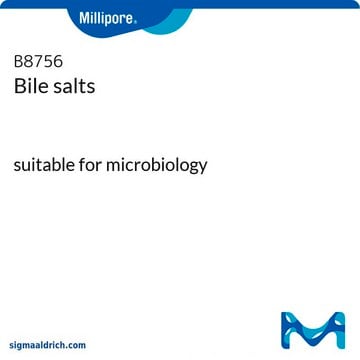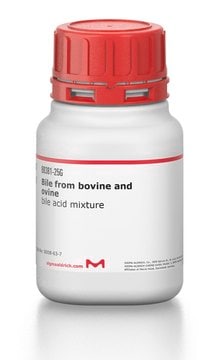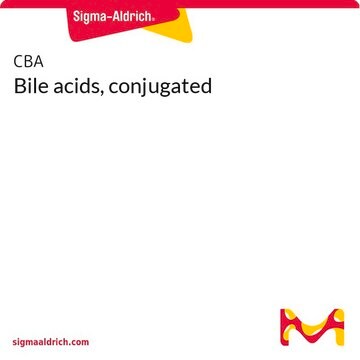The product B8631 should be considered a crude extract. In terms of solubility, quality control testing indicates that this product is tested for solubility in 80% ethanol at a concentration of 10 mg/mL, resulting in a slightly hazy to very hazy, very dark yellow solution. The color of the solution is within the acceptable range specified in the current Specification Sheet.
B8631
Bile extract porcine
Synonym(s):
Bile acids, Hog Bile Powder
About This Item
Recommended Products
Application
- as a supplement in brain heart infusion (BHI) medium to culture Listeria monocytogenes LO28[1]
- to investigate the survival of probiotic bacteria through the gastric-small intestine[2]
- as a supplement in BHI mediato study the effect of oxygen on bile resistance in Listeria monocytogenes[3]
Biochem/physiol Actions
Quality
Testing Method
Storage Class Code
11 - Combustible Solids
WGK
WGK 3
Flash Point(F)
Not applicable
Flash Point(C)
Not applicable
Personal Protective Equipment
Choose from one of the most recent versions:
Certificates of Analysis (COA)
Don't see the Right Version?
If you require a particular version, you can look up a specific certificate by the Lot or Batch number.
Already Own This Product?
Find documentation for the products that you have recently purchased in the Document Library.
Customers Also Viewed
-
What is the preparation method for B8631 and its solubility?
1 answer-
Helpful?
-
-
I would like to know if this product contains taurocholic acid and sodium taurodeoxycholate and how much of each. Thank you
1 answer-
Taurocholic acid and sodium taurodeoxycholate are not tested on a lot to lot basis for this product. However, historical data reveals that typically this material contains approximately 4-7% taurodeoxycholic acid and 30-40% taurocholic acid.
Helpful?
-
-
What are the best solvents that can be used to solubilize this product?
1 answer-
This product is soluble in 80% ethanol at 10mg/mL which yields a slightly hazy to very hazy solution. This material may also be dissolved in water at 50mg/mL. However, this will yield a turbid solution.
Helpful?
-
-
What is the content of cholesterol (it should mostly be free cholesterol) in B8381 and B8631?
1 answer-
Neither B8381 nor B8631 have been evaluated for cholesterol content. The approximate amount of known components of both are listed below:
8.0 - 9.5 % cholic acid
0.9 - 1.1 % deoxycholic acid
32 - 36 % conjugated cholic acid
11 - 13 % conjugated deoxycholic acidHelpful?
-
-
What is the proper temperature for storage?
1 answer-
This product is stored at room temperature.
Helpful?
-
Active Filters
Our team of scientists has experience in all areas of research including Life Science, Material Science, Chemical Synthesis, Chromatography, Analytical and many others.
Contact Technical Service













